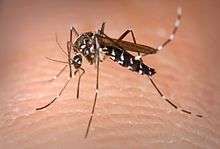Mosquitoes. Hate them.
Especially the Asian Tiger Mosquitoes that we have in San Gabriel.
Especially the ones that carry West Nile Virus. Sad and true.
Identification can start with by killing one (Good job! +1 point), and then, if you didn’t do that with too much enthusiasm, you should be able to inspect the dead insect. Notice the banded coloring on the legs: light & dark. If your dead mosquito has solid black legs, then you’ve caught a regular, non-Asian Tiger mosquito. Try again.
Their bites itch SO more than normal mosquitoes. These annoying pests fly about 3-4 feet off the ground (aka, low and out of sight), are quieter than the “normal” mosquitoes, and they hit/bite you multiple times, like guerrilla warfare. All of this behavior is unlike the lazy insects from my youth (and other states) that would land on you and were so slow that I saw a childhood friend squeeze his bicep and burst one. Okay, that last part is a myth but the regular mosquitoes are much slower and will sit on you long enough to crush them flat.
I read somewhere (I’ll look for the link later) that if all the mosquitoes disappeared from the planet at one time, no other creature would be adversely affected. I’m guessing that there might be a drop in population of some birds and spiders, maybe even dragonflies which apparently eat mosquito larvae. But according to that article, all other creatures eat other items in addition to mosquitoes.
These Asian Tiger mosquitoes purportedly arrived in the USA via car tires from other lands, which had water pooled in them.
They’ve now reached San Gabriel, CA. I’ll add a map of their current local infestation soon. It’s grim.
They have been detected to carry, and hence, inject the West Nile Virus into humans. The ones here, in San Gabriel
I imagine the mosquitoes have spread to adjacent San Marino too. If I am pissed at not being able to use my backyard, imagine how disturbed the millionaires must be.
San Gabriel Mosquito Control
They showed up, two different times, nice guys. Second guy tried to catch them in our yard (failed), then said they found and fixed a nearby problem – likely a pond or kiddie pool left unchecked that was spawning the mosquito larvae.
We still had them.
But if you’re local, do call them, and maybe they can help educate people about not leaving standing stagnant water where these bugs will breed.
The San Gabriel Valley Mosquito & Vector Control District site provides a LOT of great information. It’s the one of best government websites I’ve ever seen. Information includes what’s so bad & how did they get here.
This 2015 map shows their spread. I had a more current one that I’ll update when I find it again.

What Works Is…
Lemon-eucalyptus spray: To me, this works only slightly better than citronella candles, mostly because you can apply it to yourself. It works like many other so-called repellents by masking our delicious human scent (& exhaled carbon dioxide). Which means it doesn’t work all that great, and the skeeters will still be annoying as they play with your mind as you wonder if they might still be going for your ankles & legs where you missed a spot.
A box fan or two: I found a YouTube video where this guy in the south attached window screen mesh to large fans. Now, THAT killed a lot of mosquitoes. I’ve done some experimenting in my backyard and I’ve confirmed that it does improve the situation in two ways:
- It circulates the air and blows the buggers away.
- It pins the biters against the screen until they either die from dehydration, my finger, or a water-based spray that includes rubbing alcohol. Although, the latter has been less useful — my finger works best.
That’s my best recommendation. Get two box fans, point them both at your patio furniture, where you will be sitting, attach window screen to the back using tape or magnets, turn them on and enjoy some reasonable escape from the biters. The breeze does increase the chill-factor but you can always don another piece of clothing as you celebrate winning you backyard back from the blood-sucking demons.
Don’t Bother With…
Bug zappers: These are an expensive ruse. Zappers do NOT catch mosquitoes. Skeeters are not attracted by light. Apparently not even the ones that exude carbon dioxide to simulate human breath work very well. But I’ll add a link to those too, because I’ve heard others claiming they do in fact work. Maybe they work on normal mosquitoes?
Also note that zappers are basically only good for killing moths that, in my case, lay their eggs in the lemon tree leaves, causing them to curl and get sticky. Zappers also kill lacewing insects that are predators against many other bugs you don’t want in your garden.
Citronella candles: Sure they smell good but in my experience, they don’t really do more than mask your delicious human scent. If you’re not sitting right beside one, or rather with these low-flying stealth Asian Tiger mosquitoes, if you don’t have this lit candle down near your legs (I’m kidding – that’s absurd & dangerous), then these don’t help much.
Deet: Yes, it works, but don’t. For your own health. Deet melts plastic. Seriously, Deet. Melts. Plastic. Can’t be good for your skin or lungs.
More Information
Aedes albopictus (Stegomyia albopicta), from the mosquito (Culicidae) family, also known as (Asian) tiger mosquito or forest mosquito, is a mosquito native to the tropical and subtropical areas of Southeast Asia; however, in the past few decades, this species has spread to many countries through the transport of goods and international travel.[1] It is characterized by its black-and-white-striped legs, and small black-and-white-striped body.
This mosquito has become a significant pest in many communities because it closely associates with humans (rather than living in wetlands), and typically flies and feeds in the daytime in addition to at dusk and dawn. The insect is called a tiger mosquito for its striped appearance, which resembles that of the tiger. Ae. albopictus is an epidemiologically important vector for the transmissionof many viral pathogens, including the yellow fever virus, dengue fever, and Chikungunya fever,[2] as well as several filarial nematodes such as Dirofilaria immitis.[3] Aedes albopictus is capable of hosting the Zika virus[4][5] and is considered a potential vector for Zika transmission among humans.
<this is one my old blog entries that was mothballed… I’ll recover/rewrite it more soon, including adding links to YouTube and handy items on Amazon.>


